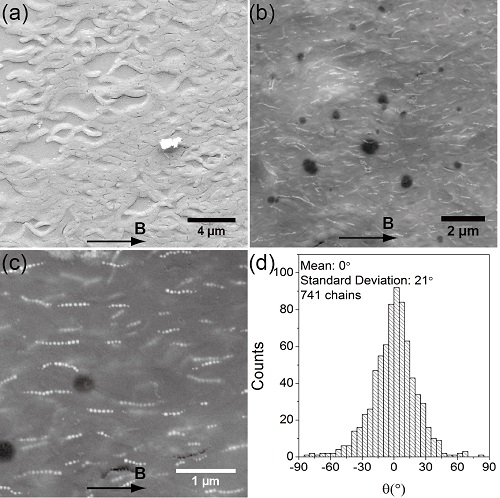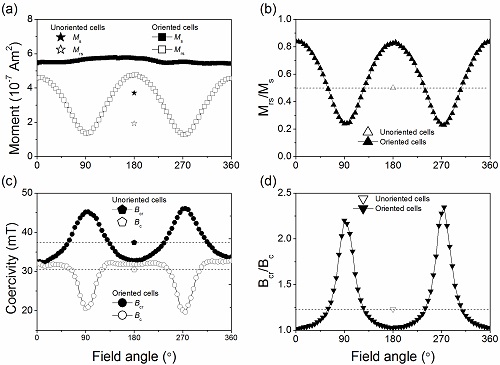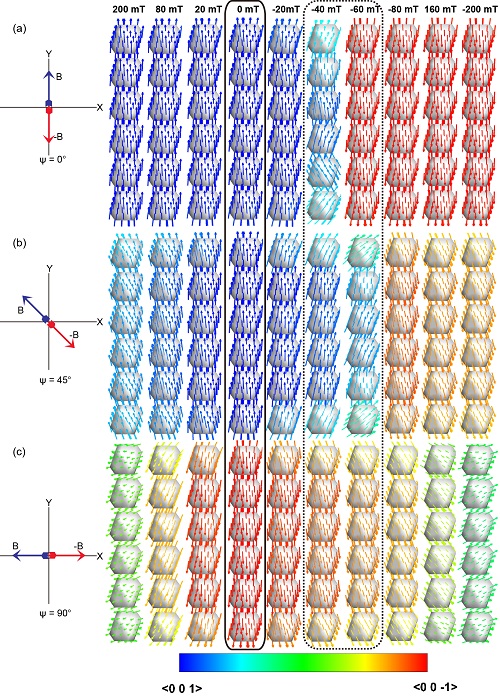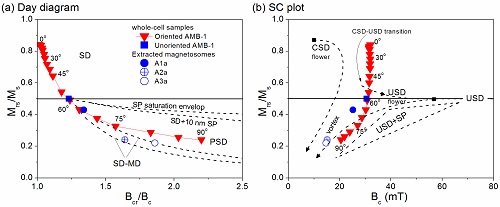A strong angular dependence of magnetic properties of magnetosome chains: Implications for rock magnetism and paleomagnetismUpdate time:12 23, 2013
Vice Professor LI Jinhua and his team investigate angular variation of magnetic properties of aligned Magnetospirillum magneticum AMB-1 cells, each of which contains one single fragmental chain of magnetosomes. With measurements at increasing angles from the chain direction, we observed that (i) the hysteresis loop gradually changes from nearly rectangular to a ramp-like shape (e.g., Bc and remanence decrease), (ii) the acquisition and demagnetization curves of IRM shift toward higher fields (e.g.,Bcr increases), and (iii) the FORC diagram shifts toward higher coercivity fields (e.g., Bc,FORC increases). For low-temperature results, compared to unoriented samples, the samples containing aligned chains have a much lower remanence loss of field-cooled (δFC) and zero-field-cooled (δZFC) remanence upon warming through the Verwey transition, higher δ-ratio (δ = δFC/δZFC) for the measurement parallel to the chain direction, and lower δ-ratio, larger δFC and δZFC values for the perpendicular measurement.
Micromagnetic simulations confirm the experimental observations and reveal that the magnetization reversal of magnetosome chain appears to be noncoherent at low angles and coherent at high angles. The simulations also demonstrate that the angular dependence of magnetic properties is related to the dispersion degree of individual chains, indicating that effects of anisotropy need to be accounted for when using rock magnetism to identify magnetosomes or magnetofossils once they have been preserved in aligned chains. Additionally, this study experimentally demonstrates an empirical correspondence of the parameter Bc,FORC to Bcr rather than Bc, at least for magnetite chains with strong shape anisotropy. This suggests FORC analysis is a good discriminant of magnetofossils in sediments and rocks.
Figure 1.
Figure 2.
Figure 3.
Figure 4. Li et al. A very strong angular dependence of magnetic properties of magnetosome chains: Implications for rock magnetism and paleomagnetism. Geochemistry Geophysics Geosystems, 2013, 14(10): 3887-3907, doi: 10.1002/ggge.20228 (Link)
|
Contact
Related Articles
Reference
|
-
SIMSSecondary Ion Mass Spectrometer Laboratory
-
MC-ICPMSMultiple-collector ICPMS Laboratory
-
EM & TEMElectron Microprobe and Transmission Electron Microscope Laboratory
-
SISolid Isotope Laboratory
-
StIStable Isotope Laboratory
-
RMPARock-Mineral Preparation and Analysis
-
AAH40Ar/39Ar & (U-Th)/He Laboratory
-
EMLElectron Microscopy Laboratory
-
USCLUranium Series Chronology Laboratory
-
SASeismic Array Laboratory
-
SEELaboratory of Space Environment Exploration Laboratory
-
PGPaleomagnetism and Geochronology Laboratory
-
BioMNSFrance-China Bio-mineralization and Nano-structure Laboratory

 Print
Print Close
Close



